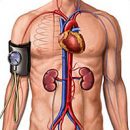Dental implants - one of the most progressive teeth restoration methods. The idea is that a special metal rod is implanted in the jaw, which serves as a support for a new tooth (or a prosthesis replacing the teeth group).
Indication for teeth implantation
Leave «as it is» The situation of lack of even one tooth is categorically impossible - even in the absence of visible discomfort. First, the entire dental row suffers (the neighboring teeth bend down in the direction of the gap, the tooth of the opposite jaw is put forward in the interval). Then, due to the developed deformation of the bite, problems begin with the rest of the teeth (as well as with the stomach due to poor-quality chewing). With sufficient neglection situation, changes can already be on the face - specific folds, wrinkles.
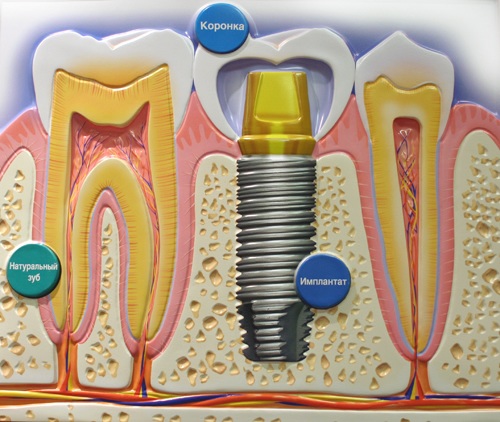
It would seem normal «Bridge» The prosthesis can correct the situation. But here arise their problems. First, it requires sharpening of the neighboring teeth (which is undesirable to do if they are healthy). Secondly, such a solution is impossible at the ends of the dentition. And, thirdly, such a prosthesis does not interfere with the bone atrophy directly under the missing tooth - the chewing load is transmitted not to the jaw, but to the neighboring teeth, thereby loosening them and tilting towards the gap. Because of this, over time, the prosthesis breaks, as a rule, together with supporting teeth.
Thus, the implantation of the teeth is the best way from the following problems:
- the absence of one tooth with healthy neighboring;
- lack of chewing teeth;
- large defects (lack of several teeth in a row);
- Complete lack of teeth on the jaw (mini-implants for attaching a removable prosthesis or complete non-removable prosthetics).
Contraindications: Absolute and relative
Nevertheless, there are some contraindications for this method of restoring the tooth row. First of all, these are the health problems that eliminate the possibility of any operations (or are able to complicate them very much) - diseases of the cardiovascular system, problems with the immune system, osteoporosis (or other diseases that interfere with the bone regeneration), diseases of the endocrine system (for example, Problems of metabolism), blood disease, problems with the nervous system, oncology, tuberculosis, AIDS, Venusal Diseases, Sugar Diabetes. In some clinics, it is taken for these cases, but at the same time the risk of complications increases.
Relative contraindications are when it is impossible to perform the operation right now, but the cause is eliminated. These include periodontitis, bite pathology, diseases of the oral mucosa, insufficient volume of bone tissue. The latter is eliminated by the methods of bone plastic - special material (or artificial origin, or own bone) is introduced into the right place. In the case of the upper jaw can produce the so-called sine lifting - lifting the mucous Gaimor Pazukh and filling formed «Pocket» bone material, which in 4-6 months will germinate with young bone fibers.
How to choose a doctor (clinic)
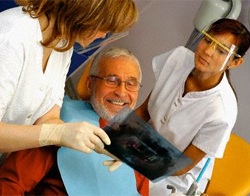
One of the necessary conditions for high-quality implantation is the right choice of clinic. First of all, focus on your own impression - the subconscious is usually wise enough to notice that something is wrong.
Also, our site advises to pay attention to the following points:
- The presence of a license for surgical intake - quality guarantees does not give, but its absence or explicit reluctance should be alarming;
- portfolio and work experience of the doctor;
- The presence of a special operating system for implants (such operations cannot be engaged in the same office, where they are treated from purulent diseases!);
- Before the operation, you must assign a versatile diagnosis, including a tomogram - for the adequacy of the operation planning specifically for your case;
- You must advise not only an implantologist, but also a prosthetist orthodontist - usually these are different doctors. The implantologist enters the implant, and the orthodontist prosthetist already creates a new tooth on it, which must harmoniously fit into your dentition (for this, the implant must be installed under a strictly defined angle, and this is not always the most convenient angle for the implantologist);
- Better when a surgical pattern is used for operation - a device that ensures the accuracy of the implant installation accuracy in accordance with the previously developed model;
- In a really good clinic, you will definitely provide a guarantee (for 10 or more years of the Implant service), will also provide significant discounts on the re-implantation of the implant in case of rejection.
Let's also pay attention to the financial issue. Usually under the term «Dental implantation» Dentists understand the implant entry actually. Crown (it can be different) - for a fee. Also in some clinics distinguish the actual implantation operation and the cost of the implant itself (can also be very different). All such moments are better stated before the start of treatment, in order to avoid unpleasant surprises.
Some clinics offer to buy a whole service with one package - that is, at the beginning of treatment, a fixed amount is negotiated, about half is made immediately, the rest in the course of treatment. In this case, in case of complications, you will not take additional money. In our opinion, this option is optimal - if there is such an opportunity, of course.
Installation of dental implants
So you decided on the clinic. Before installing dental implants, first of all, all relative contraindications will be eliminated. In parallel with this, computer will be developed, and then the volumetric model of your genuine value of your jaw. It is according to this model an orthodontist prosthetist and an implantologist will jointly produce a surgical pattern specifically for you. This is such a record that will be fastened on your teeth at the time of operation, and the holes prepared according to the model in it will help your implantologist to do everything exactly as planned.
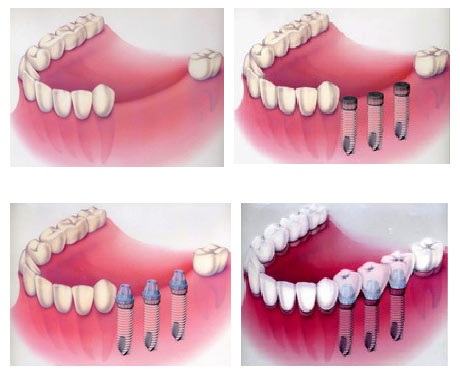
Distinguish «Two-stage» and «single-stage» implantation, as well as implantation immediately after the removal of the tooth. What is better to specifically in your case, you will tell you your doctor.
Two-stage implantation takes the most time, but is also the most reliable method. According to this scheme, the implant is first introduced and is entirely closed with a mucous membrane (so it is in contact with the oral cavity, not loaded and t.D.). From two months to six months it goes to ensure that the implant is in the bone. After high-quality rustling (controlled with X-ray shots), the abutment is screwed into the implant - the transitional part between the implant and the actual tooth. After 1-2 weeks, when he arrives, a titanium tooth with a ceramic crown will be put on it.
Single-step implantation is characterized by the fact that the abutment is screwed at the same time with the introduction of an implant. Typically, they put record implants in this way (and with a two-stage - implants of an injurious, more physiological form).
Stopping an implant immediately after removal of the tooth is applied quite rarely, because at first it is necessary to massive the rest of the oral cavity. If the situation allows - it is better to put an implant as soon as possible so that the bone does not have time to atrophy.
After operation

For the first couple of weeks after the operation you will have to eat only soft cool (not cold and not hot) food - from the other will hurt, and there is a risk to prevent the healing process. If you smoke, try to refrain at least the first week - almost all complex cases of postoperative complications were associated with smoking.
How to abide by the hygiene of the operated region, will tell your implantologist. Most likely it will be a rinse with antiseptic solutions after each food intake, then (in 2-3 weeks) - a soft toothbrush.
If bleeding occurs in the field of the implant, it is immediately necessary to press in this place with your finger (clean, naturally!) until the bleeding stop (usually about 20 minutes). If it did not help to stop the blood, then our site recommends one of the following ways: either attach to the place of bleeding wet compress from black tea, or hold very cold water in the oral cavity (it will stop bleeding for five minutes).
If the doctor persists with painful medicines, carefully follow the instructions, and remember that such drugs usually cause drowsiness - that is, it is better not to drive a car, refrain from cycling and t.D. Consider also with alcohol painting interact in the best way.
Mini implants
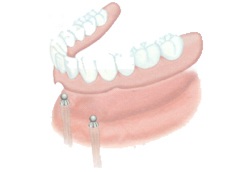
This technology is designed specifically for people with complete removable prostheses. Mini implants are thin titanium screws, on which you can securely strengthen the removable prosthesis - then it does not rub the jaw, and, most importantly, due to adequate transfer of the load, the bone is not atrophied - that is, there is no need to regularly told or change the prosthesis.
There are almost no contraindications for mini implantation - only those cases when any surgical intervention is unacceptable. The price is also noticeably different.
Care for mini implants is not more difficult than the natural teeth. But they are usually not cleaned with a brush, but a thick dental thread (with a toothpaste applied to it). How exactly - your doctor will show.






